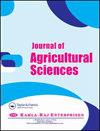Numerical Investigation of Multiphase Transport Model for Hot-Air Drying of Food
IF 0.7
Q3 AGRICULTURE, MULTIDISCIPLINARY
引用次数: 2
Abstract
Drying is widely used to prevent microbial spoilage by evaporating the determined amount of liquid in the food sample. In order to reduce energy consumption and increase food flavor quality, modeling the drying process is crucial. In the literature, different approaches are used for investigation of drying characteristic. Among these approaches, the porous media approach have complex phenomena. Molecular diffusion for gases (water vapor and air), capillary diffusion for liquid (water), and convection mechanisms (Darcy flow) were used in drying model in porous media. In this study, firstly, the effect of shrinkage on drying of porous media was investigated. Non-linear partial differential equations for air and food material in the drying problem were solved numerically for non-steady state condition. The shrinkage effect in the drying process was studied by using the ALE (Arbitrary Lagrangian Eulerian) method. In this study, air velocities of 0.5, 0.8 and 1 m s-1, air temperatures of 40, 50 and 60 °C and the geometric forms of rectangular, cylindrical and square were selected for hot air drying process. The fastest drying was obtained at square shape food at the air temperature of 60 °C and the air velocity of 0.5 m s-1. The analysis result showed that the air velocity and temperature have effect on the drying.食品热风干燥多相输送模型的数值研究
干燥被广泛用于通过蒸发食品样品中确定量的液体来防止微生物变质。为了减少能源消耗和提高食品风味质量,对干燥过程进行建模是至关重要的。在文献中,不同的方法被用于研究干燥特性。在这些方法中,多孔介质方法具有复杂的现象。多孔介质干燥模型采用了气体(水蒸气和空气)的分子扩散、液体(水)的毛细扩散和对流机制(达西流)。本文首先研究了收缩对多孔介质干燥的影响。在非稳态条件下,对空气和食品物料干燥问题中的非线性偏微分方程进行了数值求解。采用ALE(任意拉格朗日-欧拉)方法研究了干燥过程中的收缩效应。在本研究中,热风干燥过程的风速为0.5、0.8和1 m s-1,空气温度为40、50和60℃,几何形状为矩形、圆柱形和方形。当空气温度为60℃,风速为0.5 m s-1时,方形食品的干燥速度最快。分析结果表明,风速和温度对干燥有一定的影响。
本文章由计算机程序翻译,如有差异,请以英文原文为准。
求助全文
约1分钟内获得全文
求助全文
来源期刊

Journal of Agricultural Sciences
AGRICULTURE, MULTIDISCIPLINARY-
CiteScore
1.80
自引率
0.00%
发文量
0
 求助内容:
求助内容: 应助结果提醒方式:
应助结果提醒方式:


